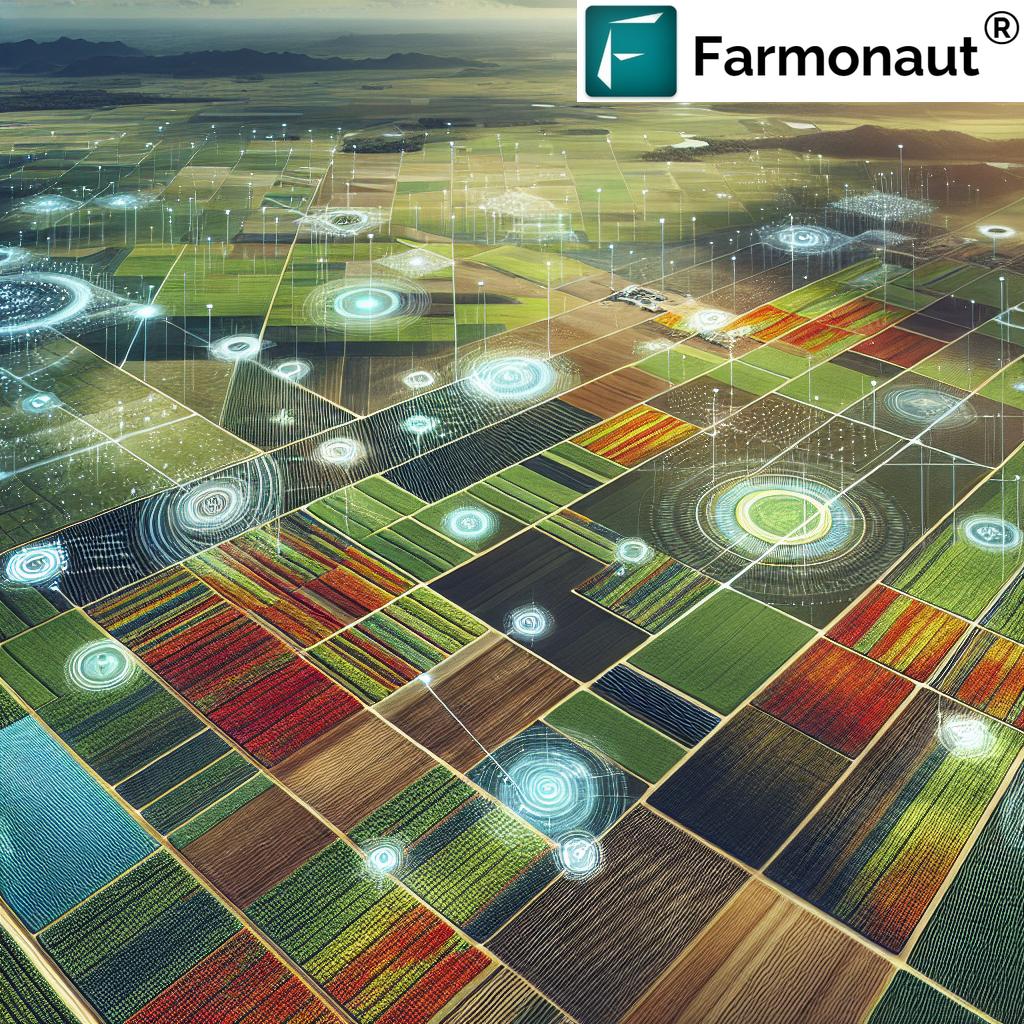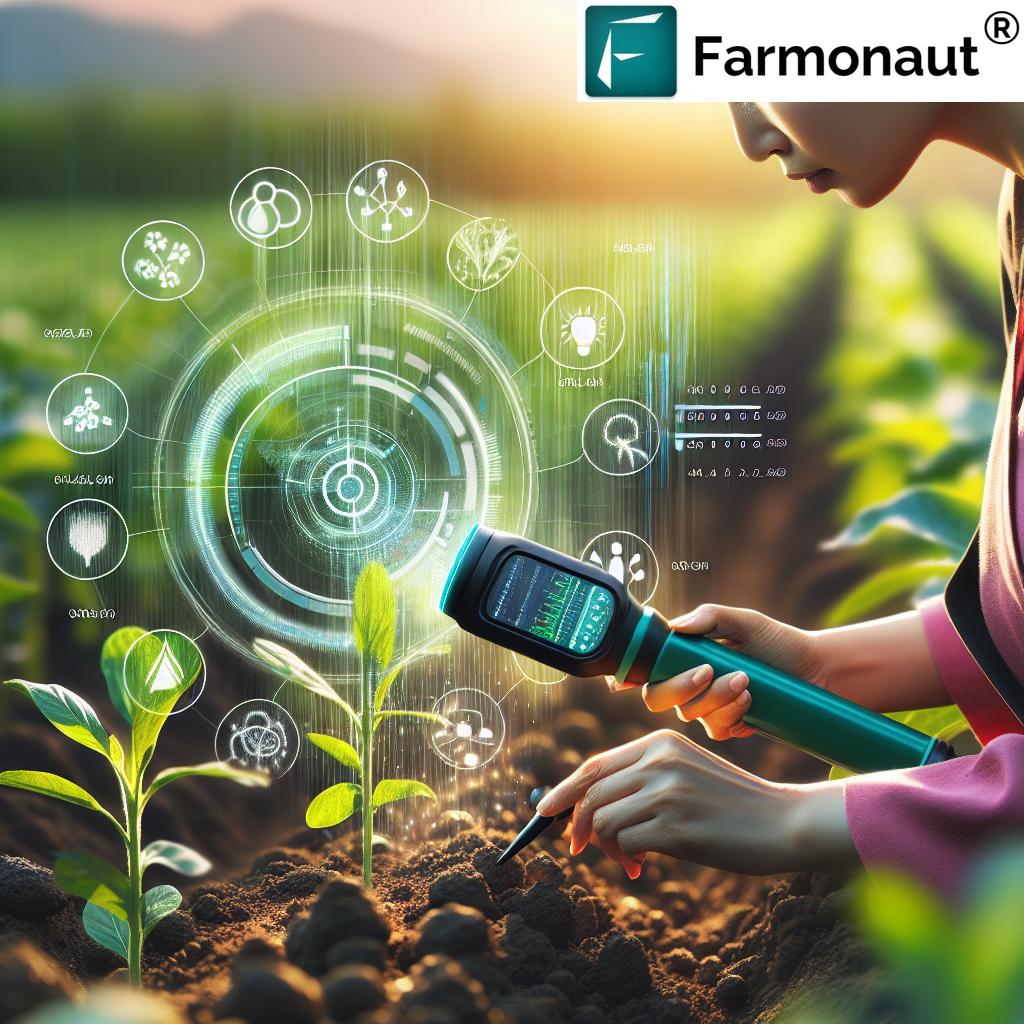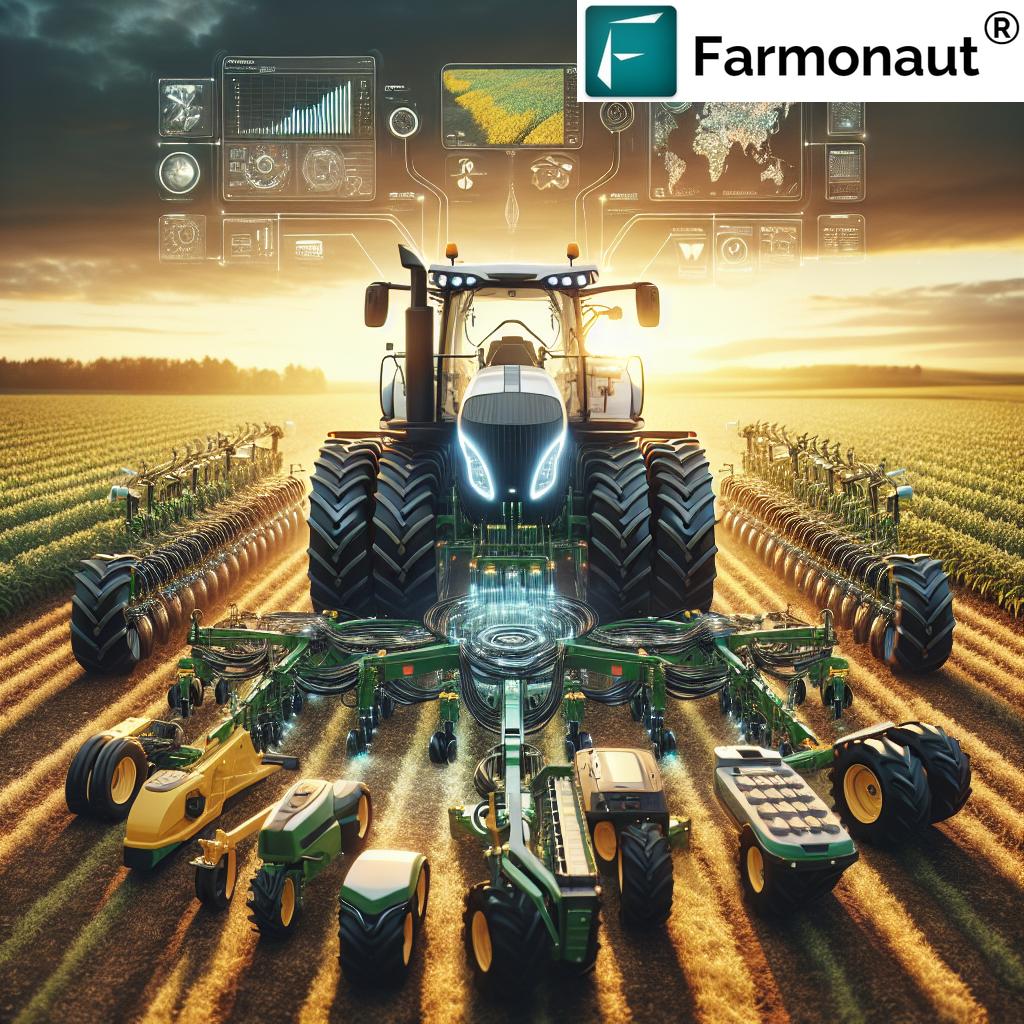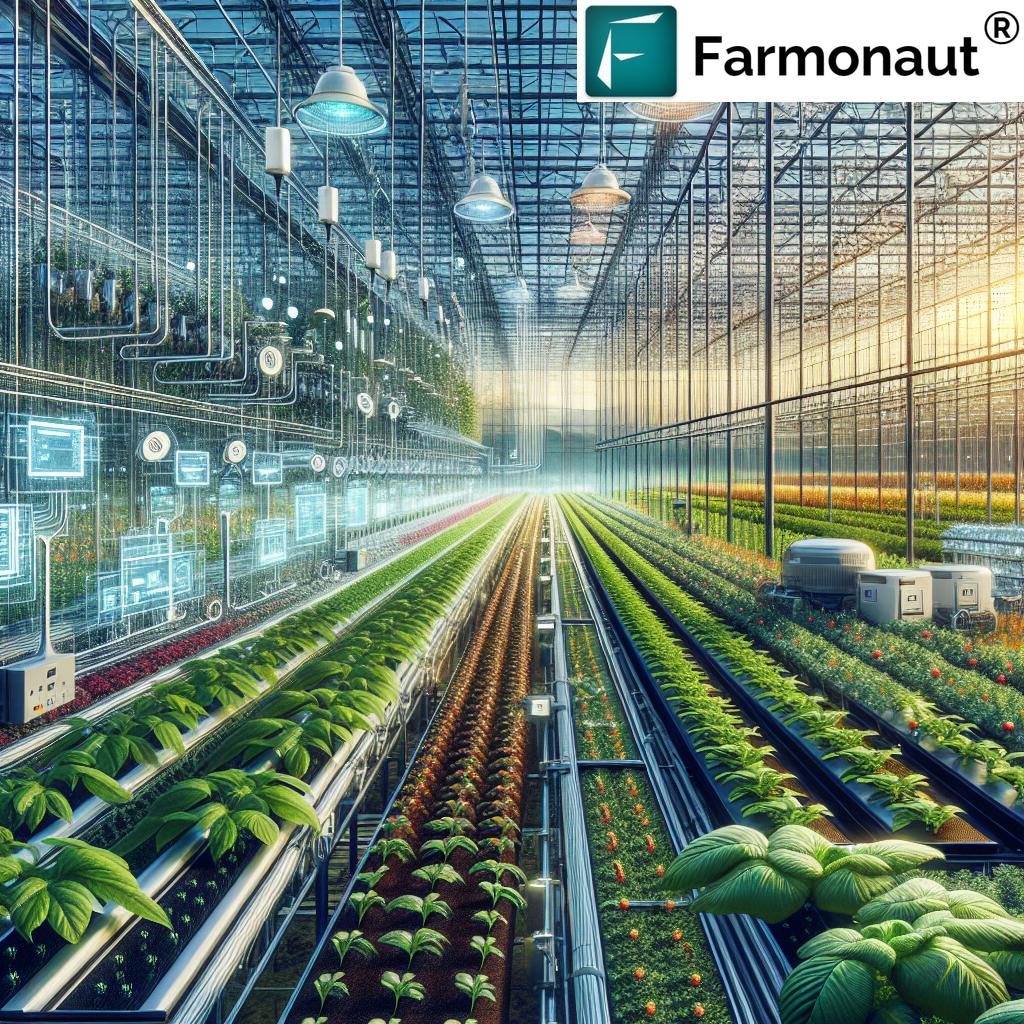Table of Contents
- Introduction: Precision Agriculture & Yield Optimization
- Key Components of Precision Grow Yield Optimization Tools
- Comparative Feature & Impact Table
- Practical Applications in Yield Optimization
- Benefits of Precision Yield Optimization Tools
- Farmonaut: Making Precision Agriculture Accessible
- Challenges and Considerations in Implementation
- The Future of Precision Agriculture and Yield Optimization
- Frequently Asked Questions
- Farmonaut Subscription Plans
“Precision agriculture can increase crop yields by up to 20% using data-driven optimization tools.”
Unlock Massive Yields: Precision Grow Yield Optimization Tools
At the forefront of agricultural innovation, precision grow yield optimization tools are transforming how we cultivate crops, manage resources, and support sustainable farming practices. By integrating advanced technologies like sensor networks, the Internet of Things (IoT), remote sensing, AI, and data analytics, we empower farmers to make better-informed decisions, boost their crop yields, and conserve vital resources such as water and fertilizers. The world is witnessing a paradigm shift—precision agriculture is no longer futuristic; it’s the present-day approach to tackling food security, environmental challenges, and the urgent need for productivity.
In this comprehensive guide, we’ll demystify precision grow yield optimization, exploring its key components, practical applications, real-world benefits, and the challenges farmers face while adopting these technologies. We’ll also highlight how Farmonaut is making precision agriculture more affordable and accessible across diverse farming landscapes.
“Advanced yield optimization technologies can reduce resource waste by as much as 30% in modern farming.”
Key Components of Precision Grow Yield Optimization Tools
To fully unlock the advantages of crop yield optimization, modern agricultural systems rely on a combination of hardware devices, data-driven processes, and advanced analytics. Let’s break down each essential element:
1. Sensor Networks & IoT Devices
Precision farming technologies start at the ground level. Sensor networks incorporate IoT-enabled sensors that constantly collect real-time data about important field parameters—soil moisture, temperature, nutrient levels, and crop health. Through continuous monitoring, farmers gain immediate insights into current conditions, enabling precise adjustments to irrigation or fertilization strategies. These IoT devices minimize manual labor while maximizing accuracy and timeliness.
- Soil health monitoring: Detects spatial variability across fields to optimize nutrient management and conserve resources.
- Real-time detection: Quickly identifies changing crop conditions and potential pest risks.
2. Remote Sensing Technologies
Remote sensing in agriculture leverages satellites, drones, and aerial imagery to provide comprehensive views of each field. Multispectral and hyperspectral imaging picks up early signs of crop stress, deficiencies, and infestations—even those invisible to the naked eye. This rapid diagnosis allows for timely interventions and supports targeted management.
- Satellites and drones: Offer broad coverage to assess field health on a large scale.
- Aerial imagery: Reveals detailed crop stress patterns and waterlogging issues.
3. Geographic Information Systems (GIS)
GIS software transforms raw data from the field (like soil characteristics, yield records, and crop health metrics) into detailed maps. These visualizations assist in understanding spatial variability and inform smarter resource allocation decisions.
- Helps identify fields with high or low productivity.
- Supports zonal management and tailored fertilization practices.
4. Artificial Intelligence (AI) & Machine Learning (ML)
AI in farming is rapidly advancing, allowing us to analyze vast datasets to predict crop yields, assess pest risks, and recommend optimal planting schedules. ML algorithms continuously improve with exposure to historical and real-time data, enhancing the accuracy of forecasts and recommendations.
- Identifies yield-limiting factors automatically.
- Assesses environmental conditions to simulate optimal strategies.
5. Variable Rate Technology (VRT)
Variable rate technology applies inputs like fertilizers, pesticides, and water at variable rates across each field. By targeting input application to actual crop requirements, VRT optimizes resource use, reducing both waste and environmental impact.
- Precision irrigation systems: Deliver water based on current soil moisture and local weather data.
- Site-specific nutrition: Ensures every plant gets exactly what it needs—no more, no less.
6. Advanced Data Analytics & Software Platforms
All the above technologies are woven together by robust data analytics platforms. These tools aggregate, analyze, and visualize agricultural data, transforming raw sensor or satellite feeds into actionable insights. That’s where leading platforms like Farmonaut come in—offering farmers and agribusinesses a centralized dashboard for all their monitoring and decision-making processes.
- Real-time monitoring dashboards
- Visual maps for rapid assessment
- Integrations with custom business APIs for large-scale farm management
Comparative Feature & Impact Table: Leading Precision Grow Yield Optimization Tools
| Tool Name | Core Technology Used | Estimated Yield Increase (%) | Resource Savings (% Water/Fertilizers) | Sustainability Impact | User Adoption Level |
|---|---|---|---|---|---|
| Farmonaut | Satellite Imaging, AI/ML, Blockchain, IoT Integration | 15-20% | 20-30% | High (carbon tracking, resource conservation) | Medium to High |
| John Deere Operations Center | Fleet IoT Sensors, Data Platforms | 10-15% | 10-20% | Medium | High (large commercial farms) |
| Climate FieldView | Remote Sensing, Cloud Data Analytics | 10-18% | 12-20% | Medium (input savings, less waste) | High |
| Trimble Ag Software | GIS, VRT, Sensor Networks | 12-17% | 15-25% | Medium-High | Medium |
| Granular | Data Management, Apps, Analytics | 10-15% | 10-18% | Medium | Medium |
Note: The above figures are based on industry averages and estimated impacts. Actual results will depend on local adoption, crop type, and implementation precision.
Practical Applications in Yield Optimization
Precision agriculture is only as valuable as the real-world improvements it delivers. Let’s delve into practical cases where precision grow yield optimization tools revolutionize our farming practices:
Precision Irrigation Systems
- Smart irrigation solutions combine soil moisture data, weather forecasts, and remote sensing analytics to optimize the amount and timing of water application.
- This directly supports large-scale farm management by conserving water and protecting against drought.
- Helps reduce costs associated with water pumping and energy consumption.
Fertilizer Management & Nitrogen Simulation
- Advanced platforms simulate the nitrogen cycle using field-specific analysis, providing customized fertilizer recommendations to boost nutrient use efficiency.
- Precision fertilization minimizes environmental impact and supports sustainable farming practices.
- Farmonaut’s Carbon Footprinting goes further by tracking emissions related to fertilizer application.
Pest & Disease Detection
- AI-powered systems monitor crop imagery to detect early pest infestations or disease outbreaks.
- Targeted application of pesticides means smaller quantities and less risk to beneficial organisms, enhancing both efficiency and biodiversity.
- Combines field-level monitoring with expert agronomic advice for faster response.
Yield Prediction and Harvest Planning
- Integrating soil, weather, imagery, and management data, AI models predict crop yields with increasing accuracy.
- Supports farmers in market forecasting, resource planning, and reducing post-harvest losses.
Blockchain-Based Traceability
- Blockchain brings full transparency and traceability to agricultural supply chains.
- This gives food processors and brands access to verifiable data from “farm to fork.”
- Farmonaut’s product traceability solutions build customer trust and help farmers meet export or regulatory requirements.
Fleet, Resource, and Operations Management
- Fleet management tools monitor agricultural machinery to reduce operational costs, ensure timely maintenance, and enhance safety.
- Centralized dashboards help manage crews, tasks, and deliveries—crucial for large or distributed farming businesses.
- Facilitates compliance and access to crop loans and insurance through satellite-verified reports.
Soil and Vegetation Monitoring
- Continuous soil health monitoring enables us to maintain and enhance long-term productivity.
- Vegetation indices (e.g., NDVI) and remote sensing identify areas of stress or degradation early for remedial action.
“Advanced yield optimization technologies can reduce resource waste by as much as 30% in modern farming.”
Benefits of Precision Grow Yield Optimization Tools
When implemented strategically, precision grow yield optimization tools deliver a cascade of benefits across the agricultural value chain:
- Increased Efficiency & Productivity: Automated data collection and analysis save time, cut unnecessary labor, and streamline resource allocation.
- Resource Conservation: Optimized irrigation, fertilizer, and pesticide applications drastically reduce costs, while conserving precious soil and water resources for future generations.
- Sustainability: Sustainable farming practices—enabled by accurate monitoring, soil health analysis, and carbon footprinting—lower the environmental burden of agriculture.
- Improved Decision-Making: Farmers are empowered to make informed decisions based on real-time, data-driven insights for maximum yield optimization.
- Early Detection & Risk Reduction: Rapid identification of stress, deficiencies, or pest threats prevents crop losses and secures income stability.
- Facilitated Financing: Satellite and blockchain data enable streamlined loan approvals and insurance claims, especially through platforms like Farmonaut’s crop loan and insurance verification.
Farmonaut: Making Precision Agriculture Accessible
Modern agriculture demands affordable, easily deployable precision tools. As a leader in agricultural technology, Farmonaut’s mission is clear—democratize access to precision farming by eliminating high upfront costs and making advanced solutions available to farmers worldwide via intuitive mobile and web platforms.
How Farmonaut Stands Out
- Leverages satellite imagery for plant health, soil moisture, and vegetation analysis via NDVI and multispectral remote sensing.
- Offers Jeevn AI Advisory System for personalized, real-time crop management strategies.
- Implements blockchain-based traceability for accountable, transparent supply chains.
- Facilitates large-scale plantation management and fleet management with automated field and vehicle monitoring.
- Enables resource management and carbon tracking to maintain sustainability targets.
- Accessible via web, Android/iOS apps, and dedicated API integrations (API developer docs available).
Frequently Asked Questions: Precision Grow Yield Optimization Tools
1. What is precision agriculture, and how does it improve crop yield?
Precision agriculture is a modern farming approach that uses advanced tools and data analytics to monitor, manage, and optimize every aspect of the growing process. By leveraging real-time data on soil, weather, and crop health, farmers can make targeted interventions, ultimately improving crop yields and resource efficiency.
2. Which technologies are most essential in yield optimization?
Key technologies include IoT sensors, remote sensing (satellites and drones), AI and machine learning, GIS, and software analytics platforms. These work together to provide precise, actionable insights for every phase of a crop’s life cycle.
3. How do precision optimization tools benefit sustainability?
They reduce unnecessary input use (water, fertilizers, pesticides) and minimize waste. Platforms such as Farmonaut also offer carbon footprint monitoring, supporting eco-friendly, climate-smart farming.
4. Are these tools affordable for small and medium farmers?
Yes—modern solutions like Farmonaut’s satellite-based system eliminate the need for expensive infrastructure and on-field hardware. This makes precision agriculture accessible via mobile and desktop apps, matching the budget and scale of smallholder farmers.
5. How do I get started with Farmonaut?
Download the Farmonaut app for Android or iOS, or sign up on the web platform. Explore the plantation and forest advisory services, satellite crop monitoring, and add-ons such as blockchain-based traceability and fleet management.
6. Is there API access for developers or larger operations?
Absolutely—Farmonaut’s API is available for integration, and developer documentation helps businesses maximize the power of precision agricultural data analytics.
7. What’s the role of blockchain in agriculture?
Blockchain ensures each step of the food supply chain is transparent, verified, and tamper-proof, vital for traceability and consumer trust. Explore blockchain-based solutions for product traceability here.
Challenges and Considerations in Precision Agriculture
While precision tools deliver immense value, successful implementation requires overcoming real-world challenges:
- High Initial Investment: Upfront costs, especially for hardware-based systems, may be a barrier for smallholder farmers.
- Data Management: Handling and processing large-scale farm data demands robust infrastructure and technical expertise.
- System Integration: Multiple devices and software must work in harmony—Farmonaut’s modular platform offers flexibility and API support for seamless integration.
- Training and Support: Farmers and agribusinesses must receive hands-on training, access to support teams, and ongoing updates as systems evolve.
Choosing a service provider like Farmonaut, known for its user-friendly interface and comprehensive support services, helps mitigate several of these hurdles.
The Future of Precision Agriculture and Yield Optimization
As food demand, climate volatility, and environmental regulation intensify, the future of precision agriculture will be shaped by several exciting trends:
- Integration of Digital Twins: Virtual replicas of farms will simulate and optimize agricultural processes for preemptive decision-making.
- Enhanced AI Capabilities: AI/ML models will continue to evolve, offering even finer-grained predictive analytics and management suggestions.
- Wider Adoption of IoT: More affordable, scalable IoT devices will ensure deep, consistent monitoring of every farm section.
- Greater Sustainability Focus: New regulations and market demands will encourage eco-friendly practices, resource conservation, and transparent product traceability.
- API Economy: Platforms with robust APIs—like Farmonaut—will become the backbone for customizable, scalable, and integrated farm management.
In summary, the evolution of precision agriculture and yield optimization tools holds remarkable promise for creating food systems that are highly productive, efficient, and sustainable. By embracing these technologies, farmers worldwide can secure better harvests, healthier soils, and a more resilient future.
Farmonaut Subscription Plans
Ready to unlock real-time satellite-powered crop insights, AI-driven farm advisories, traceability, and sustainable resource optimization?
Farmonaut offers flexible and affordable subscription models suitable for individual farmers, cooperatives, agribusinesses, and government organizations.
Conclusion: Empowering Farmers for a Data-Driven Future
Precision agriculture is revolutionizing the world’s food systems by combining advanced tools, data analytics, AI, IoT, satellite remote sensing, and sustainable practices for unprecedented yields and resource efficiency.
- Farmers can monitor, manage, and optimize their entire operation with unmatched accuracy.
- Farmonaut is at the heart of this transformation—removing technological barriers and offering truly affordable, user-centric precision grow yield optimization solutions.
- Through responsible resource management, traceability, and carbon footprint tracking—we ensure future generations inherit productive, resilient lands.
The agricultural future is smart, sustainable, and data-driven.
Join us—empower your farm with precision today!













